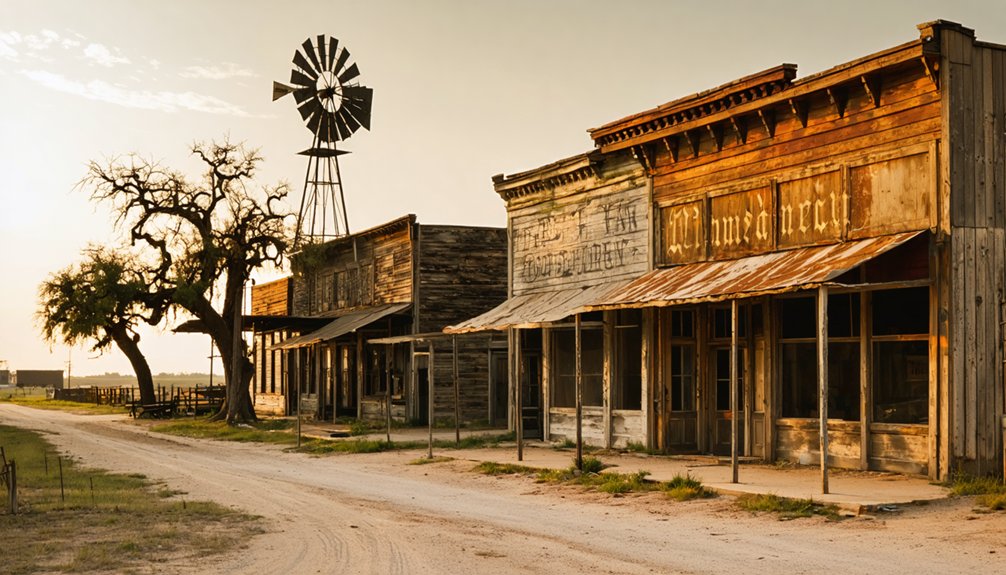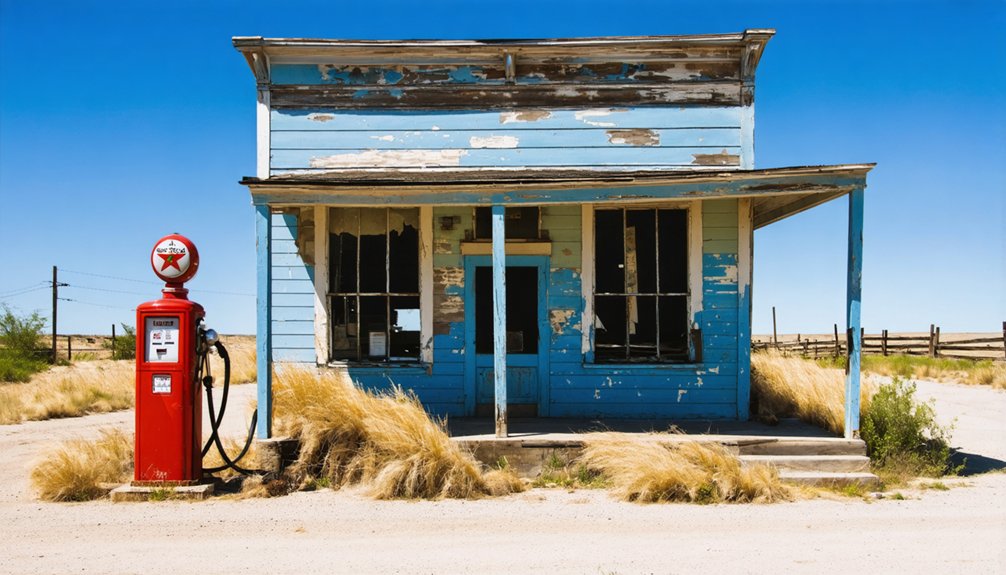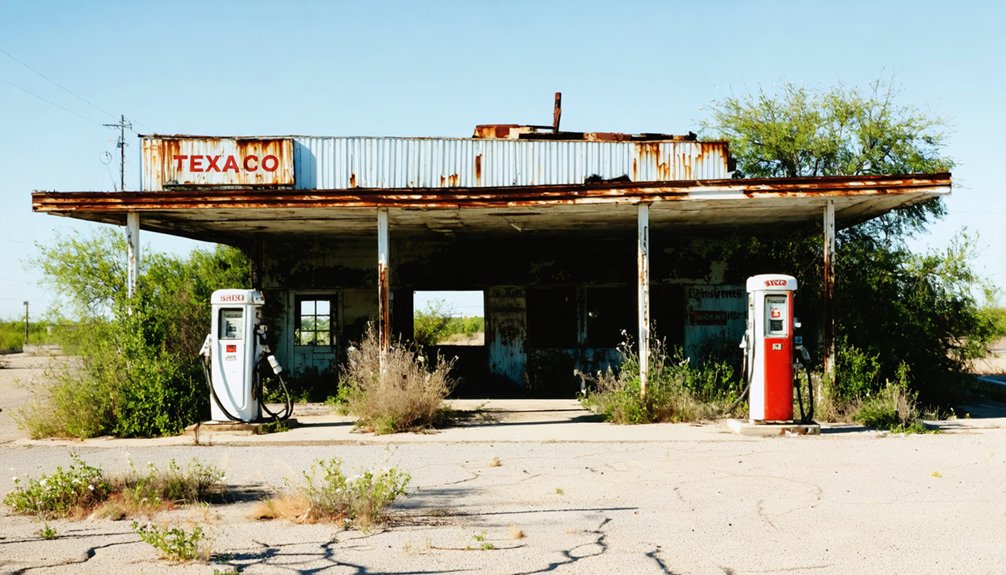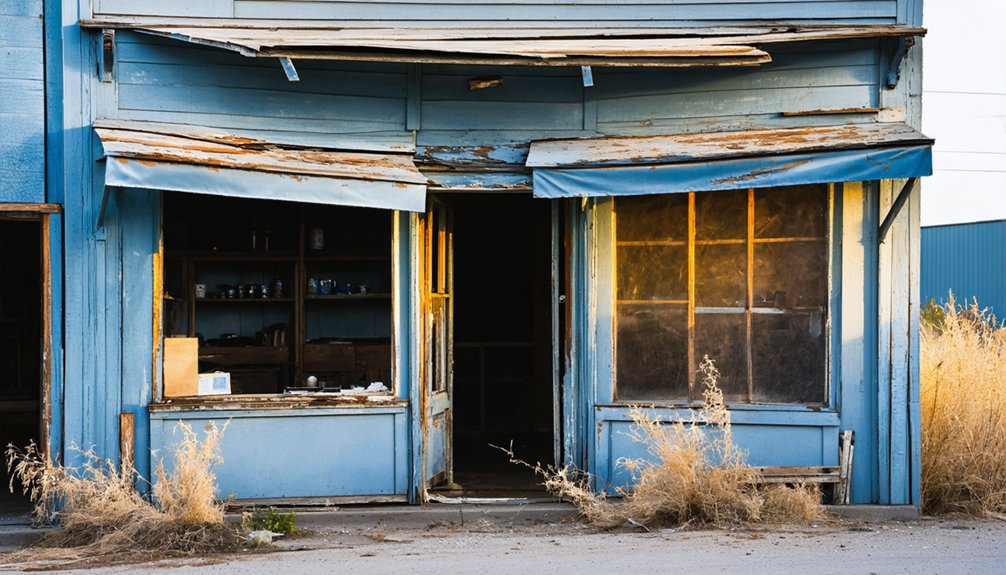You’ll find Hackberry’s ghost town story differs from typical Texas ghost towns. Founded in 1846 by Ludwig Von Neuhaus, this German settlement evolved from a frontier village with steam-powered mills and cotton gins into a thriving modern community of nearly 3,000 residents in Collin County. While its Victorian Gothic architecture and historic cemetery chronicle its pioneer past, Hackberry’s transformation from a small farming town reveals an unexpected tale of resilience and growth.
Key Takeaways
- Despite being labeled a ghost town by some sources, Hackberry is an active Texas community with nearly 3,000 residents.
- The town maintains modern infrastructure and full municipal services while preserving its historical German heritage.
- Hackberry’s Victorian Gothic houses and two-story stone store represent its architectural legacy from the mid-19th century frontier.
- The historic cemetery documents generations of settlers, providing tangible evidence of continuous habitation since 1846.
- The town benefits from proximity to growing suburbs like Frisco and Little Elm, contributing to its ongoing vitality.
The Birth of a Frontier Settlement (1847)
When Ludwig Von Neuhaus arrived in Texas from Germany in 1846, he recognized the strategic potential of an area dotted with hackberry trees halfway between Houston and San Antonio.
You’ll find that his choice of location wasn’t random – it reflected the settlement challenges faced by pioneers seeking both accessibility and resources.
By establishing agricultural operations and naming the settlement after its distinctive grove of hackberry trees, Neuhaus laid the foundation for a new community identity on the Texas frontier.
The earliest residents came from Peters Colony settlements, establishing farms and homesteads throughout the area.
As the settlement took root in 1847, it marked more than just another spot on the map – it marked the beginning of organized frontier life in what would become Lavaca County.
The community’s agricultural focus would soon expand, setting the stage for future development and contributing to 500 years of Texas history.
Steam Power and Agricultural Progress
As you explore Hackberry’s agricultural evolution, you’ll notice the town’s early mills played an essential role in supporting local farming needs through water- and animal-powered operations by the 1850s.
The introduction of steam power transformed these agricultural operations, particularly in grain processing and cotton production, making the work markedly more efficient. The saw and grist mills operated by the Neuhaus family were vital to the community’s early prosperity. The region’s energy landscape would later shift dramatically when wind power generation became prominent in nearby areas.
While steam-powered machinery revolutionized farming practices across Texas in the late 19th century, Hackberry’s potential for further industrial growth was ultimately limited when railroad routes bypassed the settlement.
Mill Operations and Growth
Three major developments transformed Hackberry’s agricultural landscape in the 1850s and beyond. It started with L.E. Neuhaus’s establishment of a steam-powered sawmill and gristmill in 1853, revolutionizing local grain processing.
You’d have seen the addition of a cotton gin shortly after, expanding the mill complex’s capabilities.
The impact of this mill technology rippled through the community, driving remarkable growth. By the 1880s, you could find seven steam-driven gristmill-cotton gins operating in Hackberry, processing larger quantities of agricultural products than ever before.
The mills attracted German immigrants in the 1860s and spurred the development of supporting businesses. With a population reaching 300 by 1884, you’d have witnessed a thriving hub of stores, schools, and churches – all evidence of the prosperity that steam-powered processing brought to this Texas community. The bustling town supported a thriving general store since 1865, which was later rebuilt to accommodate growing business. A Methodist church was constructed in 1861, serving dual purposes as both a place of worship and education until 1896.
Cotton Processing Evolution
Cotton gins evolved to incorporate cutting-edge suction systems and automated compression, dramatically reducing manual labor.
Universal-density presses streamlined cotton baling at gins by eliminating the need for traditional compresses.
Module builders protected cotton quality by limiting exposure to weather and dirt before processing.
Co-operative gin operations, like Texas Cotton Industries, brought efficient shared processing services to local producers.
River steamers transported the processed cotton bales efficiently from local gins to major Gulf ports for export.
Steam-Powered Economic Impact
During the mid-1800s, steam-powered machinery revolutionized agricultural practices across America, fundamentally transforming farming communities like Hackberry, Texas.
Steam innovation enabled farmers to break free from traditional limitations, as new engines powered everything from plows to cotton gins with unprecedented efficiency. The Cooper company’s development of self-propelled engines in 1875 marked a major advancement in farming technology.
You’d have witnessed a remarkable shift in Hackberry’s economic landscape as agricultural mechanization took hold. By 1870, while steam cable-plowing had become widespread in England with 3,000 operating units, American farmers were slower to adopt the technology.
Steam-powered mills and processing facilities became the heartbeat of local commerce, allowing farmers to process crops faster and serve broader markets.
This technological leap didn’t just boost productivity – it freed farmers from the costly maintenance of draft animals and helped them overcome seasonal constraints.
The result? Larger, more diverse farming operations that strengthened the community’s economic foundation and secured its place in Texas’s agricultural transformation.
Religious and Educational Foundations
Religious and educational foundations in Hackberry, Texas emerged through the establishment of a Methodist church in 1861, which served as both a spiritual center and schoolhouse for the growing community.
German immigrants, led by Ludwig Von Neuhaus, shaped the town’s cultural identity through their strong Methodist faith and commitment to education. The church-school building fostered community cohesion until its destruction by fire in 1896.
The German Methodist settlers of Hackberry built more than a church – they created the cultural foundation of their Texas community.
- You’ll find that religious services and education were intertwined, reflecting the immigrant influence of early settlers.
- The post office’s establishment in 1861-1862 complemented these institutions, creating a civic hub.
- German traditions and values continued to impact local culture even as the town declined after being bypassed by the railroad.
Peak Years and German Immigration

Settlement patterns in Hackberry, Texas took shape when Ludwig Eduard Neuhaus arrived from Ellerburg, Germany in 1846, purchasing 1,150 acres in northern Lavaca County.
You’ll find that German heritage played a defining role as Neuhaus actively recruited skilled craftsmen and families from his homeland, including his brothers Franz and Hermann who joined him in 1849.
Immigration patterns centered on Neuhaus’s leadership transformed Hackberry into a thriving community by the 1850s.
The settlement, positioned along the Gonzales-San Felipe Road, soon boasted a sawmill, gristmill, and general store.
You’d have encountered a vibrant mix of German laborers, tradespeople, and prominent settlers, all contributing to daily stagecoach service and robust commerce.
The community’s cultural identity remained distinctly German, evidenced through their maintained traditions, language, and religious practices.
Economic Infrastructure and Local Commerce
You’ll find that Hackberry’s earliest economic foundation centered on Ludwig Von Neuhaus’s 1853 sawmill-gristmill complex, which provided essential processing services for local grain and lumber needs.
The addition of a cotton gin expanded the town’s industrial capacity, enabling farmers to process their cotton harvests locally rather than transporting raw materials elsewhere.
Neuhaus’s iron-shuttered general store, established in 1865 and rebuilt larger in 1880, served as both a commercial hub and secure trading post for the growing agricultural community.
Mills and Processing Centers
The economic backbone of Hackberry emerged in 1853 when Ludwig Von Neuhaus established the town’s first sawmill and gristmill complex, transforming the settlement into an essential agricultural processing hub.
You’ll find that this mill technology laid the foundation for Hackberry’s growth, with processing innovations expanding to include a cotton gin in the late 1850s. The combined operations served local farmers who needed lumber cut, grain ground, and cotton cleaned – critical services that helped them avoid lengthy trips to distant facilities.
- The sawmill converted raw timber into usable lumber for construction and commerce
- The gristmill processed wheat and other grains into flour and meal
- The cotton gin separated valuable cotton fibers from seeds, boosting regional cotton production
These processing centers made Hackberry a crucial commercial nexus until their eventual decline in the early 1900s.
General Store Evolution
While Hackberry’s mills processed the region’s raw materials, a different kind of economic center would emerge in 1934 – the Northside Grocery.
You’d find this general store evolution fascinating, as it transformed from a crucial Conoco station and grocery hub into a beloved Route 66 landmark. Initially serving local ranchers and miners with daily necessities, the store adapted when Route 66’s glory days brought steady streams of travelers seeking supplies and rest.
After Interstate 40’s 1978 opening devastated local traffic, the store sat empty for 15 years until Bob Waldmire reimagined it in 1992.
Today, you’ll discover a treasure trove of Route 66 nostalgia, where vintage gas pumps and Burma Shave signs tell stories of America’s historic highway. Under the Pritchards’ ownership since 1998, it continues as a living museum and tourist destination.
Cotton Industry Development
Shortly after establishing his sawmill-gristmill in 1853, Ludwig Von Neuhaus expanded Hackberry’s economic infrastructure by opening a cotton gin that would transform the region’s agricultural prospects.
Cotton cultivation flourished as Texas production soared from 58,073 bales in 1849 to over 3.5 million by 1900. You’ll find that Hackberry’s strategic location between Houston and San Antonio made it an ideal spot for cotton commerce, though labor conditions remained harsh for workers, including European immigrants and Mexican laborers.
- The cotton gin enabled local processing, turning raw cotton into market-ready products while saving farmers long-distance transport costs.
- Railroad access amplified Hackberry’s cotton industry, connecting local farmers to national and international markets.
- Methodist churches supported the growing community, serving as both religious and educational centers for cotton farming families.
Population Decline and Post Office Closure
Since reaching its peak population of 2,981 residents in 2020, Hackberry has experienced a modest decline of 1.24%, losing 37 residents by 2023. These population shifts reflect broader changes in community dynamics, with projections indicating a continued annual decline rate of -0.4% through 2025.
You’ll find today’s Hackberry is remarkably different from its earlier days, with a diverse makeup that includes 43.2% White, 22.1% Hispanic, and 15.6% Asian residents. The median age of 32.9 years points to a relatively young community, while the robust median household income of $118,000 and high homeownership rate of 77.3% suggest economic stability.
Despite these strong indicators, post-2020 trends hint at changing migration patterns affecting this Texas community.
Final Days as an Active Community

The gradual dissolution of Hackberry’s vibrant community life became apparent in the mid-1900s as its economic foundation began to crumble.
Despite signs of community resilience, you’d have witnessed dramatic demographic shifts as younger residents sought opportunities elsewhere, leaving behind scattered farmsteads where a bustling village once stood.
The town’s final active period saw significant changes in land use, with cattle grazing and hay production becoming the primary activities.
- You can still find remnants of Victorian gothic houses and a stone general store, though they’ve been largely ransacked.
- The once-vital Methodist church, destroyed by fire in 1896, was never rebuilt, marking a turning point in community cohesion.
- The remaining inhabitants focused on subsistence farming, with fewer than 50 people maintaining their connection to the land.
Historical Legacy and Remnants
Despite its humble origins as a sawmill settlement, Hackberry’s historical legacy stands as a tribute to Texas frontier development during the mid-19th century.
You’ll find the town’s cultural memory preserved in its Victorian Gothic houses and the iconic two-story stone store with distinctive iron shutters – silent sentinels of a once-thriving community.
The town’s architectural heritage reflects its peak prosperity, when 300 residents supported multiple enterprises and German immigrants enriched the local culture.
Today, while only scattered farms and homes dot the landscape where steam mills and merchants once thrived, you can still visit the historic cemetery that chronicles generations of settlers.
These remnants tell the story of a resilient frontier town that, though now quiet, played its part in shaping Texas’s pioneering spirit.
Modern Ghost Town Status

While historical records paint a picture of Hackberry’s past, modern reality tells a different story – this active Texas town of nearly 3,000 residents bears little resemblance to a ghost town.
Today’s Hackberry thrives amid suburban development, with modern infrastructure and full municipal services. You’ll find a vibrant community that’s part of the growing Dallas-Fort Worth metroplex, served by the Little Elm Independent School District.
- Community growth continues as Hackberry benefits from its proximity to expanding suburbs like Frisco and Little Elm
- The town maintains active residential areas across its 0.69 square miles of land
- Unlike Arizona’s famous Hackberry ghost town, Texas’s Hackberry shows no signs of abandonment or decay
Don’t expect to find ghost town ruins or abandoned buildings here – this is a living, breathing community in constant evolution.
Frequently Asked Questions
Are There Any Living Descendants of L.E. Neuhaus Still in the Area?
Through the mist of local history, you won’t find definitive proof of Neuhaus family descendants still living near their ancestor’s pioneering grounds – records don’t confirm any current residents in the area.
What Caused the Devastating Fire That Destroyed the Methodist Church in 1896?
You won’t find a definitive cause in any fire investigation records or church history documents. The 1896 blaze that destroyed both church and parsonage remains a mystery to this day.
Were There Any Notable Crimes or Conflicts During the Town’s Peak Years?
You won’t find detailed crime incidents or significant conflict history documented from this period. While iron shutters on buildings suggest security concerns, there’s no evidence of major violence or disorder.
What Happened to the Equipment From the Seven Steam Gristmill-Cotton Gins?
Though seven steam mills once served 300 residents, you won’t find much preserved equipment today. Historical records don’t document the machinery’s fate, but it was likely scrapped or destroyed like most period gins.
Are There Any Photographs of Hackberry During Its Prosperous Period?
You won’t find any confirmed historic photographs from Hackberry’s prime period in town archives. While Victorian buildings still stand today, no period photos have been discovered from its prosperous days.
References
- https://www.allacrosstexas.com/texas-ghost-town.php?city=Hackberry
- https://www.tshaonline.org/handbook/entries/hackberry-tx-denton-county
- https://cityofhackberry.net/about-hackberry/
- https://www.txgenwebcounties.com/rockwall/Communities/ghosttowns.htm
- https://www.youtube.com/watch?v=3ACLylpJ36k
- https://www.texasescapes.com/TexasHillCountryTowns/Hackberry-Texas.htm
- https://www.ghosttowns.com/states/tx/hackberry.html
- https://www.tshaonline.org/handbook/entries/hackberry-tx-cottle-county
- https://www.texasescapes.com/TOWNS/Hackberry/Hackberry_Texas.htm
- https://en.wikipedia.org/wiki/Hackberry_(Lavaca_County)



